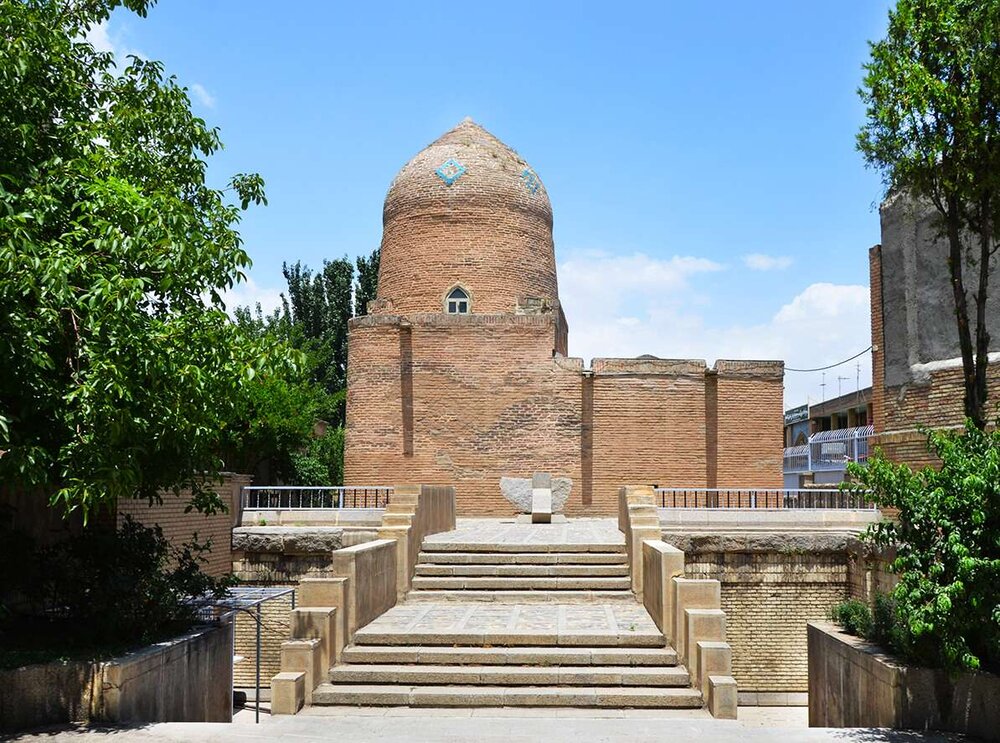Explore mausoleum of Esther and Mordechai
The purported burial site of Purim’s Persian queen and a pilgrimage site for Iranian Jews

TEHRAN – The mausoleum of Esther and Mordechai is a Jewish shrine in the city of Hamedan, west-central Iran, where, according to Judeo-Persian tradition is the burial site of the two cousins who played a pivotal role in the Book of Esther (also known as the Megillah).
This tradition, according to the Encyclopedia Iranica, is not supported by the Jews outside of Iran and does not appear in either Babylonian or Jerusalemite Talmuds. A parallel tradition holds that their bodies were brought to another place for burial. So it is not certainly known if the shrine is the actual site where Mordechai and Esther are laid to rest.
The site is also a pilgrimage site for Iranian Jews throughout the year, especially on Purim. While the original date of shrine’s construction is unknown, its date of destruction, at the hands of Mongol invaders, allegedly occurred in the 14th century.
The saga of Mordechai and Esther form the basis for the Jewish celebration of Purim [also known as the “Feast of Lots”]; hence, the site is of deep historical significance to Iranian Jews and the wider Jewish community.
According to the biblical book named after her, Esther was a young Jewish woman who caught the eye of the Persian King Ahasuerus, became queen, and with the assistance of her cousin, saved Jews throughout the Persian Empire from annihilation in the 5th century BC. Every year, on the occasion of Purim, Jews around the world mark this miraculous salvation by reading the Book of Esther, dressing in costumes, and eating delicacies.
German archaeologist and Iranologist Ernst Herzfeld (1879 –1948) contends that the current structure may actually belong to Shushan Dokht, the Jewish queen of King Yazdagerd I (ca. 399-420 CE), who is credited with securing permission for Jews to live in Hamadan.
According to the encyclopedia, Herzfeld described the place as a simple structure which has been restored several times, rejecting the tradition relating the tombs to Esther and Mordechai, who he said were buried in Susa.
Herzfeld dates the current structure to 1602 CE, partly on account of its traditional Persian architectural style (known as Emamzadeh), which was ubiquitous amongst the shrines of Muslim religious leaders built in that era. In most cases, these buildings include an entry hall and a main square hall with a domed ceiling that surrounds the sarcophagus (stone coffin).
Until the 1970s, the shrine was hidden away in a crowded part of Hamadan, surrounded by houses, and accessible only through a narrow dirt alley. But the site and its premises underwent a major renovation project in the early 1970s.
Houses around the tomb were purchased and demolished, making the shrine accessible from the main street. The renovation, however, did not significantly alter the shrine itself, or the gravestones cluttering the plaza outside the old shrine.
Known in classical times as Ecbatana, Hamadan was one of the ancient world’s greatest cities. Pitifully little remains from antiquity, but significant parts of the city center are given over to excavations. Ecbatana was the capital of Media and subsequently a summer residence of the Achaemenian kings who ruled Persia from 553 to 330 BC.
A recent media hype
Earlier this month, some foreign media outlets reported that the shrine was set on fire and destructed.
To investigate the issue, Homayoun Samayeh, the head of Tehran's Jewish community, paid a visit to the shrine. He dismissed the rumors circulating about damage to Esther and Mordechai's tomb, saying “these are media propaganda waged by enemies of the Islamic Republic.”
“Contrary to the rumors published in some media, no damage has been inflicted on the shrine of Esther and Mordechai,” Mehr quoted Samayeh as saying on the sidelines of his visit on May 17.
“Religious minorities, especially Jews, live in this country under the shadow of the Islamic Republic and all-round support from the government, and are grateful for the services of the government and the system,” he said.
“The shrine of Esther and Mordechai is completely intact, and there may be burnt carpet outside this complex in a corner which has been magnified and exaggerated by the enemies of the Islamic Republic.”
Samayeh added that the Iranian Jewish community does not allow the enemies of the Islamic Republic to use them as a tool to attain their hostile goals.
AFM/MG
Leave a Comment